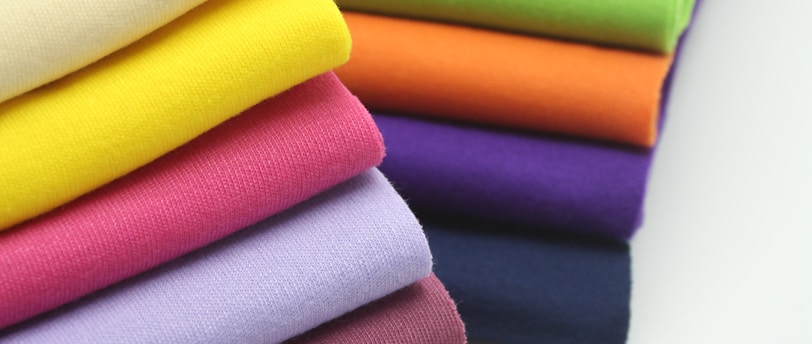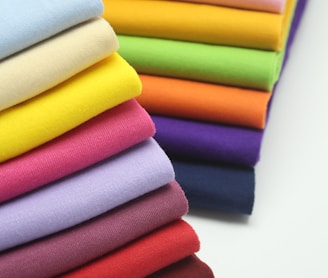Taffeta Fabric: A Guide to Its Characteristics and Uses
Taffeta fabric is a crisp, smooth, and lightweight fabric that is made from silk, polyester, or nylon. It is characterized by its tightly woven plain weave, which gives it a distinctive rustling sound when it is moved.
FABRIC GUIDE
Saleem Shahzad
6/9/20236 min read


Introduction to Taffeta Fabric
What is Taffeta Fabric?
Taffeta fabric is a crisp, smooth, and lightweight fabric that is made from silk, polyester, or nylon. It is characterized by its tightly woven plain weave, which gives it a distinctive rustling sound when it is moved. Taffeta fabric has a lustrous sheen and a slightly stiff texture, which makes it ideal for creating structured garments such as ball gowns, wedding dresses, and evening wear. It is also used for home decor items such as curtains, tablecloths, and upholstery. Taffeta fabric is available in a wide range of colors and patterns, making it a versatile choice for a variety of applications.
History of Taffeta Fabric
Taffeta fabric has a rich history that dates back to the Middle Ages. It was originally made from silk and was a luxurious fabric that was reserved for the wealthy. During the Renaissance, taffeta became even more popular and was used to create elaborate gowns and other garments. In the 18th century, taffeta was used to create the famous hoop skirts that were popular during that time. Today, taffeta is still a popular fabric and is used in a variety of applications, from high-end fashion to home decor. While silk is still the most common material used to make taffeta, it can also be made from synthetic fibers like polyester and nylon.
Types of Taffeta Fabric
Taffeta fabric comes in a variety of types, each with its own unique characteristics and uses. Some of the most common types of taffeta include silk taffeta, polyester taffeta, and acetate taffeta. Silk taffeta is known for its luxurious feel and high sheen, making it a popular choice for formal wear and bridal gowns. Polyester taffeta, on the other hand, is more affordable and durable, making it a popular choice for everyday clothing and home decor. Acetate taffeta is known for its crisp texture and is often used for lining garments or creating structured pieces such as jackets and skirts. Other types of taffeta include nylon taffeta, rayon taffeta, and cotton taffeta, each with their own unique properties and uses.
Characteristics of Taffeta Fabric
Texture and Appearance
Taffeta fabric is known for its smooth and crisp texture, which is achieved through a tight weave of fine silk or synthetic fibers. The fabric has a slight sheen that gives it a luxurious appearance, making it a popular choice for formal wear and home decor. Taffeta can also be found in a range of colors and patterns, from classic solids to bold prints. Its texture and appearance make it a versatile fabric that can be used for a variety of projects, from elegant evening gowns to decorative pillow covers.
Strength and Durability
Taffeta fabric is known for its strength and durability, making it a popular choice for various applications. Its tightly woven structure gives it a smooth and crisp texture, which not only adds to its aesthetic appeal but also enhances its durability. Taffeta can withstand wear and tear, making it ideal for use in clothing, upholstery, and home decor. Additionally, its resistance to wrinkles and creases means that it can maintain its shape and appearance even after multiple washes. Overall, taffeta fabric's strength and durability make it a reliable choice for a wide range of uses.
Breathability and Comfort
Breathability and comfort are important factors to consider when choosing a fabric for clothing. Taffeta fabric is known for its lightweight and smooth texture, which allows air to flow through easily, making it a breathable fabric. This makes it a popular choice for summer dresses, blouses, and skirts. Additionally, taffeta fabric is comfortable to wear due to its softness and flexibility. It drapes well and moves with the body, providing ease of movement and comfort. Overall, taffeta fabric is a great choice for those looking for a breathable and comfortable fabric for their clothing.
Ease of Care
Ease of Care: Taffeta fabric is relatively easy to care for, making it a popular choice for clothing and home décor. It can be machine washed on a gentle cycle with cold water and a mild detergent. However, it is important to avoid using bleach or fabric softeners, as they can damage the delicate fibers of the fabric. Taffeta should be hung to dry or laid flat to prevent wrinkles and maintain its shape. It can also be ironed on a low heat setting, but it is important to use a pressing cloth to protect the fabric from direct heat. With proper care, taffeta can last for many years and retain its beautiful sheen and texture.
Uses of Taffeta Fabric
Fashion and Clothing
Taffeta fabric has been a popular choice for fashion and clothing for centuries. Its crisp and smooth texture makes it ideal for creating elegant and structured garments such as ball gowns, wedding dresses, and evening wear. Taffeta is also commonly used for creating decorative accents such as bows, sashes, and trimmings. Its ability to hold its shape and resist wrinkles makes it a favorite among designers who want to create garments with a polished and refined look. Taffeta is available in a wide range of colors and finishes, making it a versatile fabric that can be used for a variety of fashion and clothing applications.
Home Decor
Taffeta fabric is a popular choice for home decor due to its luxurious appearance and durability. It is commonly used for curtains, drapes, and upholstery. Taffeta curtains can add a touch of elegance to any room, while taffeta upholstery can withstand wear and tear from daily use. Taffeta is also a great choice for decorative pillows and tablecloths, as it can easily be embroidered or embellished with beads and sequins. Its versatility and range of colors make it a go-to fabric for interior designers looking to add a touch of sophistication to any space.
Wedding and Special Occasion
Taffeta fabric is a popular choice for wedding and special occasion dresses due to its luxurious sheen and crisp texture. It drapes beautifully and holds its shape well, making it ideal for creating voluminous skirts and structured bodices. Taffeta is also available in a range of colors, from classic white and ivory to bold jewel tones and metallics, allowing for endless design possibilities. Additionally, taffeta is often used for table linens and chair covers at weddings and other formal events, adding an elegant touch to the decor. Overall, taffeta is a versatile and timeless fabric that adds a touch of glamour to any special occasion.
Industrial and Technical Applications
Taffeta fabric is not only used in the fashion industry but also has various industrial and technical applications. Due to its lightweight and durable nature, it is often used in the production of parachutes, hot air balloons, and kites. Taffeta is also commonly used as a lining material for jackets and coats to provide insulation and protect against wind and water. In addition, it is used in the production of flags, banners, and other decorative items due to its ability to hold vibrant colors and withstand outdoor conditions. Its versatility and strength make it a popular choice for a wide range of industrial and technical applications.
Buying and Caring for Taffeta Fabric
Choosing the Right Taffeta Fabric
When choosing the right taffeta fabric, it is important to consider the intended use of the fabric. For formal wear and bridal gowns, silk taffeta is the most popular choice due to its luxurious feel and elegant drape. Polyester taffeta, on the other hand, is a more affordable option and is often used for lining or as a base fabric for embellishments. Taffeta can also come in a variety of weights, from lightweight for draping garments to heavier weights for structured pieces. It is important to consider the weight and stiffness of the fabric when choosing the right taffeta for your project. Additionally, taffeta can come in a range of colors and finishes, from matte to shiny, allowing for endless possibilities in design.
Caring for Taffeta Fabric
Caring for taffeta fabric is relatively easy, but it does require some attention to detail. Taffeta should always be dry cleaned or hand washed in cold water with a mild detergent. It should never be machine washed or dried, as this can cause the fabric to shrink or become damaged. When ironing taffeta, use a low heat setting and a pressing cloth to prevent any scorching or melting. It's also important to store taffeta properly, as it can easily wrinkle or crease. Hang taffeta garments on padded hangers or fold them neatly and store them in a cool, dry place. With proper care, taffeta fabric can last for many years and retain its beautiful sheen and texture.
Storing Taffeta Fabric
Storing taffeta fabric properly is essential to maintain its quality and longevity. It is recommended to store taffeta in a cool, dry, and dark place, away from direct sunlight and moisture. Taffeta should be folded neatly and placed in a breathable fabric bag or wrapped in acid-free tissue paper to prevent any damage or discoloration. Avoid storing taffeta in plastic bags or containers as they can trap moisture and cause mildew or mold growth. It is also important to avoid storing taffeta with any sharp or heavy objects that can cause creases or tears. By following these simple storage tips, you can ensure that your taffeta fabric stays in excellent condition for years to come.
